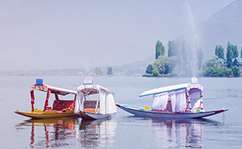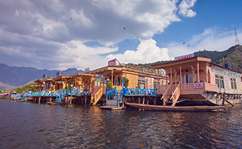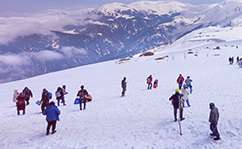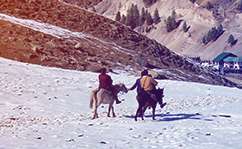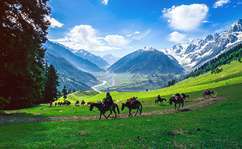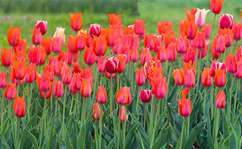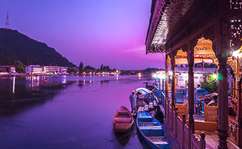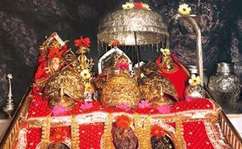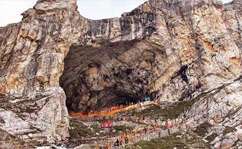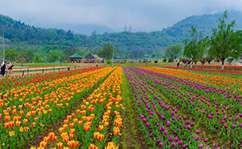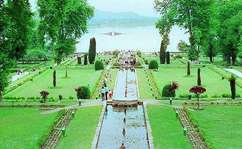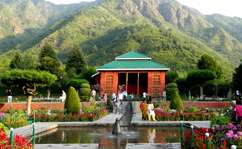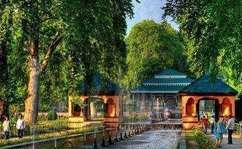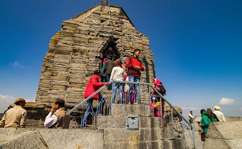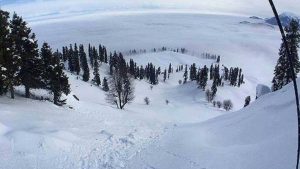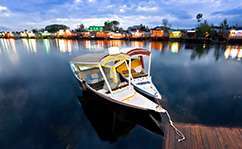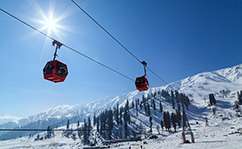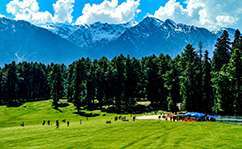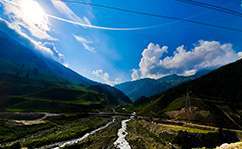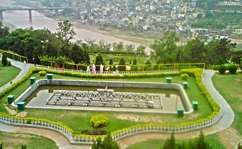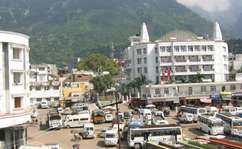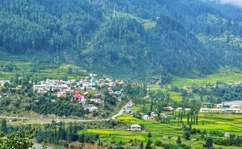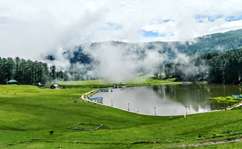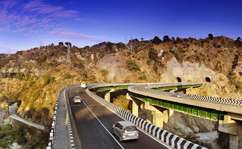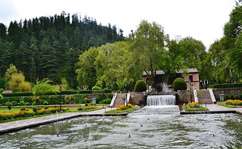Brief Introduction of Jammu & Kashmir
Jammu & Kashmir is a newly created Union Territory in India consisting of two divisions: Jammu Division & Kashmir Division, both of which are administered by the Central Government of India. It is located to the north of Himachal Pradesh & Punjab and to the west of Ladakh. Jammu is known as the City of Temples & offers plentiful sightseeing opportunities with its gardens, palaces, forts & religious attractions, the most famous of which is Mata Vaishno Devi in Katra. Kashmir Valley is famous for its meadows, lakes, high altitude passes, hill stations, Mughal Gardens, Dal Lake, Shikara Ride & ancient religious sites.
Best Selling Tour Packages
History of Jammu & Kashmir
Among the many interesting facts about Jammu and Kashmir, one is that it was a princely state during the rule of the British East India Company & the British Raj from 1846 to 1947. The princely state was formed after the 1st Anglo Sikh War. During the Partition of India & its political integration, Hari Singh, the Maharaja of Jammu & Kashmir, delayed his decision regarding integration with India.
However, on 26th October, 1947, the Maharaja acceded to India in return for military aid during the Indo-Pakistan War of 1947-48 by signing the Instrument of Accession. That was how Jammu and Kashmir came to be a part of India. Article 370, which gave special status to Jammu & Kashmir, a separate constitution, state flag & autonomy over its internal administration, was incorporated into the Constitution.
A new chapter in the history of Jammu & Kashmir was added on 6th August, 2019, when the Government of India removed Article 370 and consequently, the special status of Jammu & Kashmir. It also passed the Jammu & Kashmir Reorganisation Act, which created 2 Union Territories - Jammu & Kashmir in the west & Ladakh in the East. There are now 3 administrative divisions: Jammu Division, Kashmir Division & Ladakh.
Population of Jammu & Kashmir
According to the latest census conducted in 2011, the population in Jammu is 5.04 lakhs, while the population in Kashmir Valley is 69.1 lakhs.
Climate of Jammu & Kashmir
The climate of Jammu Region is different from Kashmir Valley, even though they receive three seasons: summer, monsoon & winter.
- Summer Season: Summer in Jammu starts from March & continues till May, with the temperature ranging between 35°C going as high as 45°C. Summer in Kashmir Valley starts from May and lasts till August, with the temperature ranging between 14°C to 30°C.
- Monsoon Season: Monsoon in Jammu starts from June & lasts till September, with the temperature ranging between 32°C to 35°C. The rainfall causes a sharp increase in the humidity levels. In Kashmir Valley, monsoon starts from July & lasts till August, with the temperature ranging from 13°C to 17°C.
- Winter Season: Winter in Jammu & Kashmir starts from October & lasts till February. While it gets quite cold in both Jammu Region & Kashmir Valley during winters, it gets much more colder in Kashmir Valley, with the temperature dropping as low as -2°C.
The temperature in Kashmir Valley ranges between -2°C to 10°C. In Jammu, the temperature in winter ranges between 4°C to 12°C, and is known as the “Winter Capital of Jammu & Kashmir”, since it offers an escape from the freezing temperatures of Kashmir Valley.
Religion of Jammu & Kashmir
The major religion of Jammu Region is Hinduism, and it is home to important Hindu pilgrimage sites, including the famous Mata Vaishno Devi Temple in Katra.
In Kashmir Valley, Islam is practised by the majority of people. Amarnath Cave, a major Hindu Pilgrimage Site, is located about 141 kilometers from Srinagar.
District of Jammu & Kashmir
- Districts in Jammu Region: There are 10 districts in Jammu Region. These are Kathua, Jammu, Samba, Udhampur, Reasi, Rajouri, Poonch, Doda, Ramban & Kishtwar.
- Districts in Kashmir Region: Kashmir Valley Region consists of 10 districts, which are Anantnag, Kulgam, Pulwama, Shopian, Budgam, Srinagar, Ganderbal, Bandipora, Baramulla & Kupwara.
Literacy Rate in Jammu and Kashmir
As per the Census 2011 (the last census conducted in India), Jammu & Kashmir has a literacy rate of 67.16%. Male literacy is 76.75%, while female literacy rate is 56.43%.
Lifestyle of Jammu & Kashmir People
The lifestyle of the Jammu people is not very different from the rest of the people of India. They are deeply religious, and value their culture heritage a lot. Religion plays a central role in their lives, and regularly visit the numerous temples scattered around the city.
Both men & women can be seen in modern as well as traditional attire. The majority of the Jammu people speak Dogri, Gojri, Pahadi, Kashmiri, Hindi, Punjabi & Urdu.
In the Kashmir Valley, people follow a traditional lifestyle, while accommodating the modern influences to a certain extent. Historically, Central Asian & Persian influences on Kashmir have been quite strong.
The traditional dress of the people here is Pheran & Poots, which is worn by both men and women. Along with this, Mughal style turbans, headgear, taranga belt of pashmina & coloured scarf are also worn by the people. The principal languages spoken are Kashmiri & Urdu.
Source of Economy
One of the sources of economy in Jammu are a number of small industries in Jammu that produce a variety of items like electronic goods and carpets. Tourism also contributes in a big way to the economy of Jammu, since it is dotted with cultural, historical & spiritual sites.
Some of the most famous are Bahu Fort, Raghunath Temple, Mubarak Mandi Palace, Bagh-e-Bahu Garden & one of the most visited Hindu pilgrimage places in India, the Mata Vaishno Devi Temple in Katra.
The primary source of revenue for the people of Kashmir Valley is agriculture & related activities along with tourism. Sericulture and cold water fisheries are other industries that provide livelihood to people in Kashmir Valley. High quality bats known as Kashmir Willow is made from the wood found in this region.
A variety of agricultural exports are also made in Kashmir including those of barley, cherries, corn, millet, orange, rice, peaches, pears, saffron & vegetables. Apples grown in Kashmir are exported throughout India and the world.
Tourism also contributes a large part to the economy of Kashmir Valley, and attracts tourists both from India and around the world, not just for its spectacular landscape but its rich culture & heritage.
Music & Dance of Jammu & Kashmir
The music of Jammu & Kashmir has been influenced by a variety of musical influences, including that of Central, Eastern & Southern Asia. Some of the most famous musical forms practiced in Kashmir are Chakri, Henzae, Ladishah, Rouf, Hindustani Classical & Sufiana Kalam.
The rich culture of Jammu & Kashmir also includes several dances that are performed during birthdays, festivals & other special occasions. Some of the traditional dance forms are Dumhal, Kud, Bhand Pather, Rouf, Hafiza & Bacha Nagma.
Cuisine of Jammu & Kashmir
Both the Jammu Region & the Kashmir Valley boast a rich cuisines, with a variety of vegetarian & non vegetarian dishes.
The cuisine of Jammu incorporates the use of several items like pulses, lentils, rice and potatoes. The Dogri dishes are a major part of its cuisine and includes a variety of dishes like Ambal, Kulthi ki Dal, Khatta Meat, Dal Patt, Maa da Madra, and Auraiya.
Pickles are also an important part of the Jammu cuisine, and greatly enjoyed by the people. Kasrod, Jimikand, Girgle, Tyaoo & Seyoo are some of the pickles served along with the main dish. Desserts like chocolate barfi, patista & sund panjeeri are the major sweet dishes in Jammu.
The cuisine of Kashmir Valley reflects Central Asian, Persian & Afghan influences. Spices like cardamom, cinnamon, fennel & cloves are widely used. One of the most famous dishes in Kashmir is Wazwan, a collection of 32 vegetarian & non vegetarian dishes.
The most popular dishes greatly enjoyed by the people are Tabakhmaaz, Shab Deg, Dum Olav/Dum Aloo, Aab Gosh, Lyader Tschaman, Runwagan Tschaman, Riste, Nader ti Gaad, Herath, Novroze, Yakhni, and the widely acclaimed Rogan Josh.
Bread is also greatly relished by the local people, with various kinds of breads like Tsot & Tsochvor, Sheermal, Lavas & Kulcha. Kehwa, a type of tea mixed with Kashmiri green tea leaves, nuts, saffron & whole spices, is served to guests and greatly enjoyed by the people too.

 +91-8744012087
+91-8744012087 Plan Your trip
Plan Your trip


